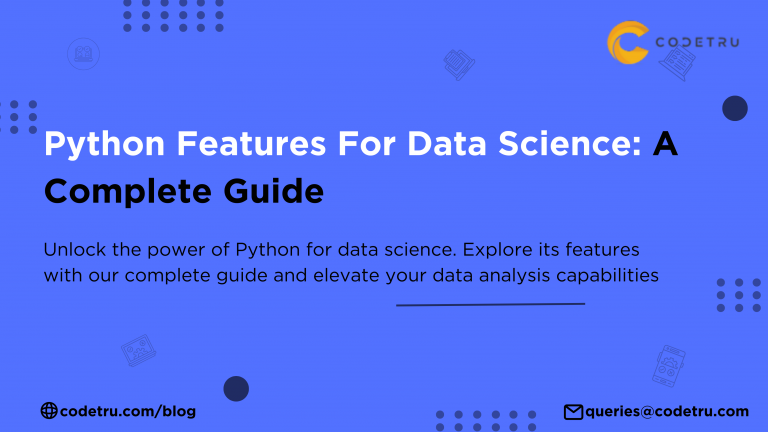What Makes Python Programming Language the Top Choice for Data Scientists?
There are over 250 computer programming languages in the world. And on top of it, there are frameworks and libraries to add further to them. Then why is Python the programming language of choice for data scientists? What features of data science and the Python language give it an edge over the other languages? Let’s figure it out in this blog today.
What is Python?
Python is an open-source, free, dynamically typed, high-level, interpreted, scientific programming language developed by Guido van Russom. It is a general-purpose cross-platform object-oriented language that can be used in multiple fields such as machine learning, data science, artificial intelligence, web application development, building games, automating processes, etc.
Features of Python language
As many as 93% of the data scientists are reported to have been using Python language according to a Kaggle survey. Nearly 24,000 professionals in the data science field were asked for their opinions on different programming languages and their reasons for choosing Python over R or SQL. Here are the top reasons why Python is the most sought-after programming language for data analysis.
It is Simple
Python is one of the easiest languages to learn and code. With its great readability and massive libraries, it offers immense flexibility to the developers to handle complex tasks efficiently.
Expressive
Python is an expressive language. Meaning, a three-line code in Java or any other programming language can be written as a single line of code in Python.
Interpreted
Python is an interpreted language. An interpreted language means that each line of code is executed one at a time, making the process of debugging easier.
Large Libraries and Frameworks
A wide range of packages can be used for scientific programming like Pandas, sci-kit learn, Numpy, Matplotlib, Seaborn, etc. for data science and data visualization in Python.
Easy Integration
Python can be easily integrated with various programming languages like C, C++, and Java can be run line by line as is the practice in Python for quick debugging of complex code.
Embedded
Python can embed other programming language code for easy implementation of certain functionalities within Python code.
Best for Automation
Python offers automation frameworks like PyUnit for effortlessly creating unit tests. Developers without a Python background also can work with unit testing using this module quite easily. Moreover, the test reports are also generated within milliseconds.
Scalable
Among all the programming languages available today, Python is popular for its scalability. Python offers flexibility which is useful for any complex app development.
Great Community Support
Python’s community is acknowledged worldwide. The community helps in easy learning of Python language, helps in bug fixes, and troubleshooting, and simplifies the learning path for newbies.
Why do Data Scientists Love Python?
Data Science is a broad field of computer science that involves various steps from data collection, data cleansing, Exploratory Data Analysis (EDA), Data modeling, data visualization, and report generation. All the below-mentioned steps can be carried out using various Python libraries or integrating with other tools for best results.
1. Data Collection and Cleansing
Python can deal with almost all sorts of data from different file formats such as CSV, TSV, JSON, etc. The libraries like PyMySQL can help import SQL tables directly into the IDE for easy cleansing of data. It can help the developers detect any missing values for extracting and replacing the missing values.
2. EDA (Exploratory Data Analysis)
Once the data is collected and cleansed, fitted with the right replacements for null values, it is time to standardize the data. You can explore and segregate the data into different types such as numerical, date, categorical, nominal, etc. for normalizing the data. The next step is to use the NumPy and Pandas libraries in Python to draw insights and identify patterns, in the data to manipulate them for best results.
3. Data Modeling
This step is the most crucial part of data science. Various algorithms like Naïve-Bayes, K-Means, and decision trees, can be used to train datasets to classify or predict the test data based on the training.
4. Data Visualization and Report Generation
Python’s data visualization packages like Matplotlib, and Seaborn can be used to generate interactive graphs, and charts, for data visualization and report generation which is a critical step of data science.
As data visualization, data presentation and reporting are imperative to data science, Python creates beautiful presentations for business use cases or integrates with Tableau or Power BI for generating reports.
FAQs on Python Features For Data Science
1. Why is Python preferred for data science?
Python is highly favored in data science due to its simplicity, extensive libraries like Pandas and NumPy, and robust community support. It offers efficient data handling, analysis, and visualization capabilities crucial for data scientists.
2. What are the key features of Python for data analysis?
Python’s key features for data analysis include its simplicity, expressive syntax, large library ecosystem, easy integration with other languages, and scalability. These features enable data scientists to perform complex tasks efficiently and effectively.
3. How does Python support data visualization?
Python supports data visualization through libraries like Matplotlib and Seaborn, which allow data scientists to create insightful charts, graphs, and interactive visualizations. This is essential for exploring data patterns and presenting findings effectively.
4. What role does Python play in machine learning?
Python is integral to machine learning with its libraries such as sci-kit learn and TensorFlow. It facilitates data preprocessing, model training, and evaluation, making it the preferred choice for developing and deploying machine learning models.
5. How can Python enhance automation in data science?
Python offers automation capabilities through frameworks like PyUnit for unit testing and integration with tools like Tableau and Power BI for report generation. It simplifies repetitive tasks in data cleansing, analysis, and reporting, improving overall efficiency.







